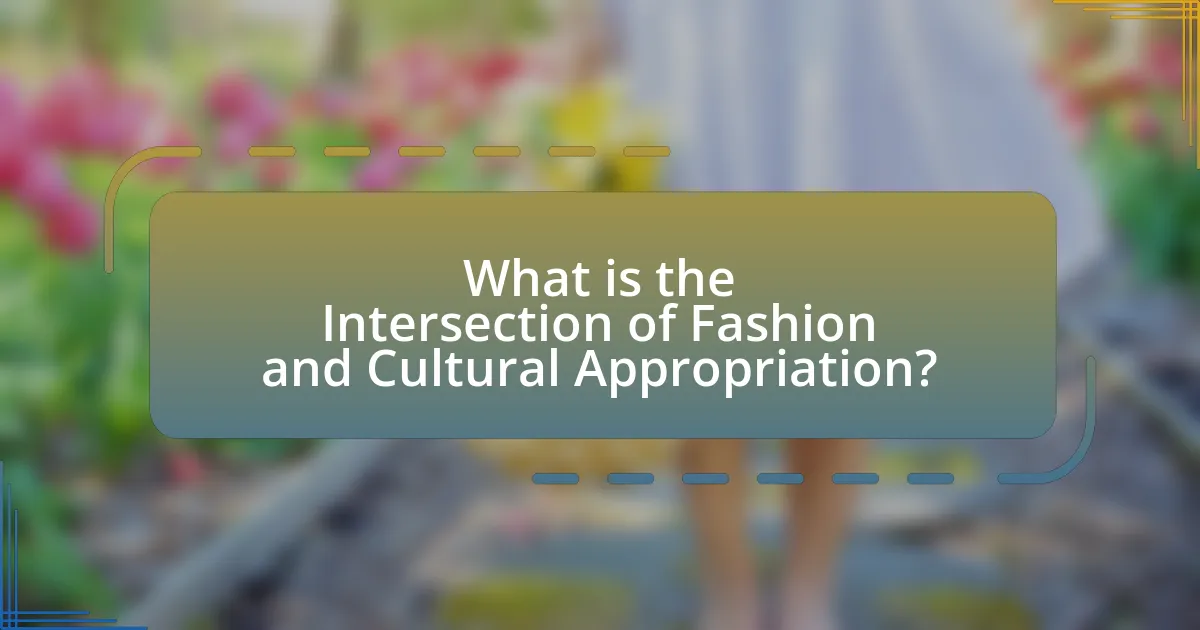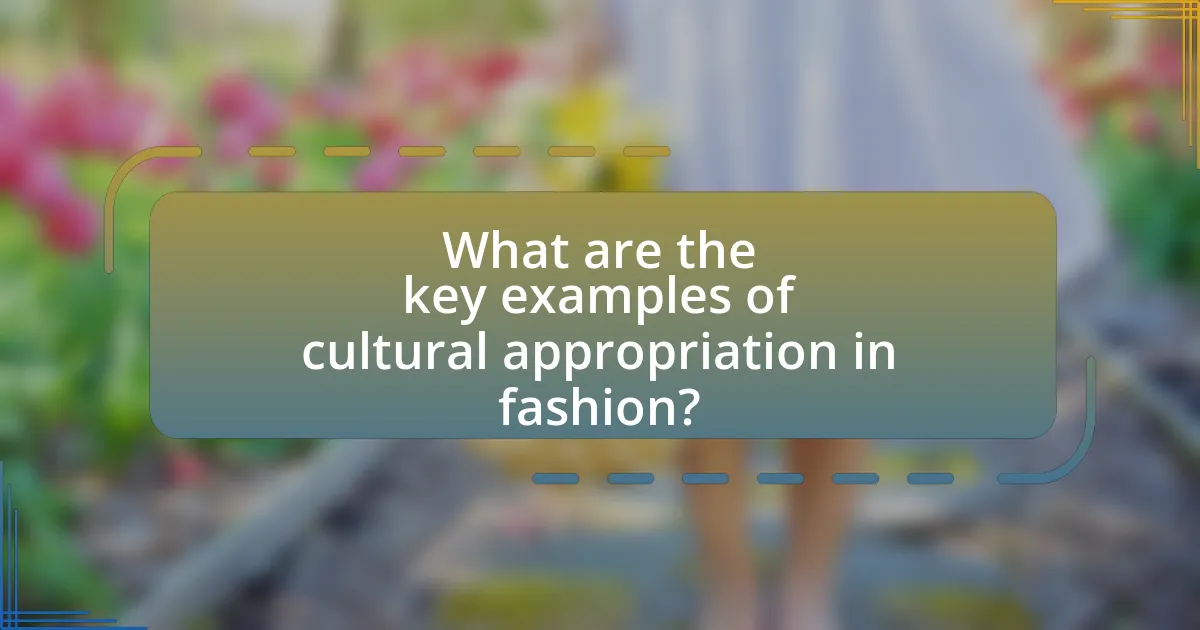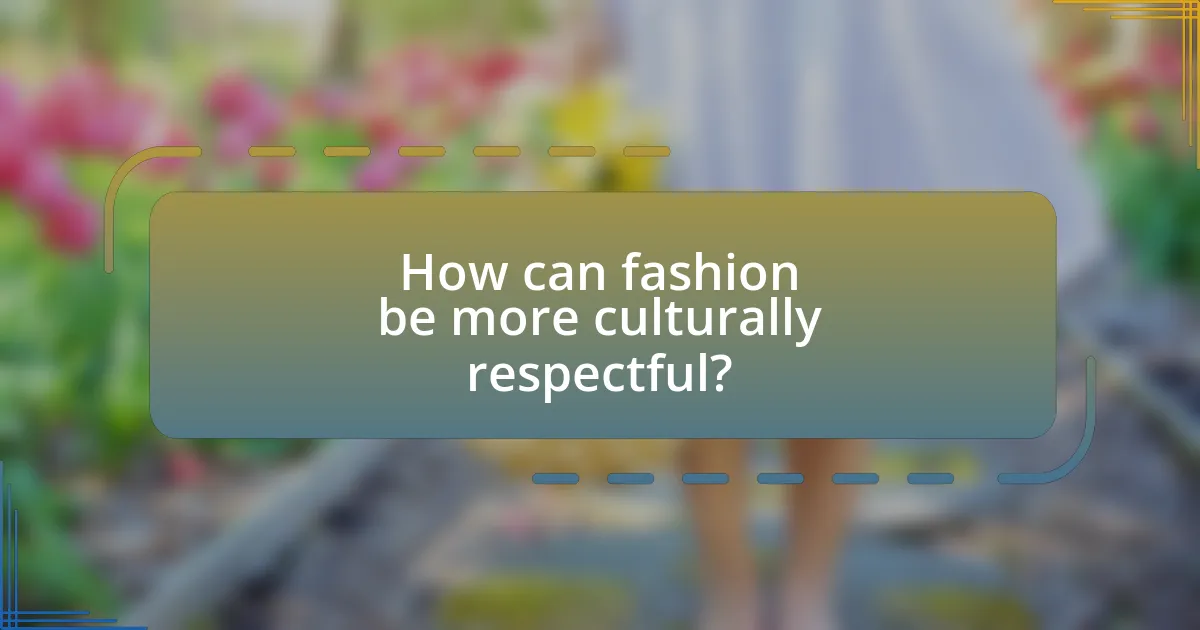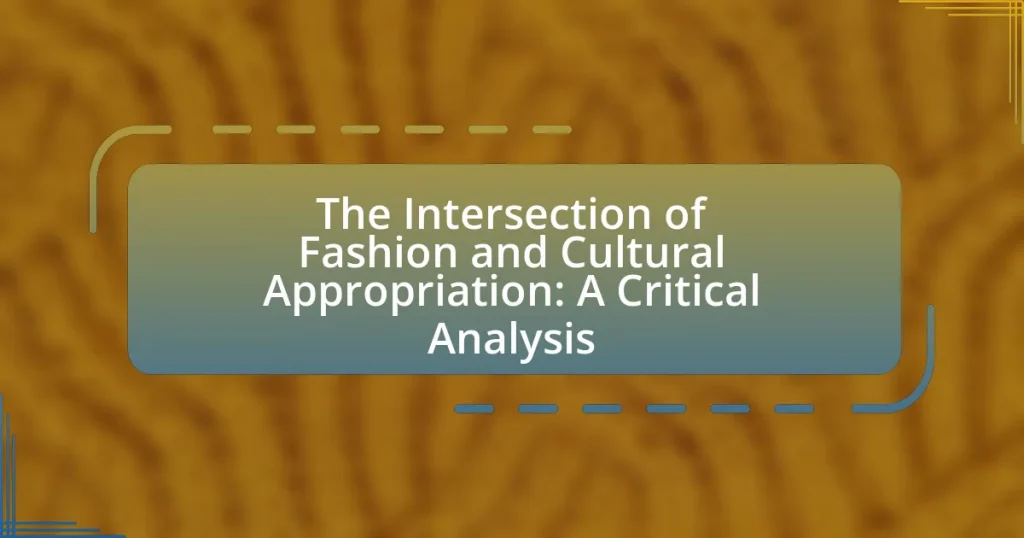The article examines the intersection of fashion and cultural appropriation, highlighting how elements from one culture are adopted by another often without understanding their original significance. It discusses the commodification of cultural symbols, the historical contexts rooted in colonialism and globalization, and the ethical implications of appropriation in the fashion industry. Key examples, such as the use of Native American headdresses and African prints, illustrate the controversies surrounding cultural insensitivity. The article also explores the role of social media in shaping public opinion and the importance of collaboration and cultural appreciation in promoting ethical fashion practices.

What is the Intersection of Fashion and Cultural Appropriation?
The intersection of fashion and cultural appropriation occurs when elements of one culture are adopted by another, often without understanding or respecting their original significance. This phenomenon can lead to the commodification of cultural symbols, where fashion designers and brands utilize traditional attire or motifs from marginalized cultures for profit, frequently ignoring the historical context and struggles associated with those cultures. For instance, the use of Native American headdresses in fashion shows has sparked controversy, as these items hold deep spiritual meaning and are not merely decorative. This appropriation can perpetuate stereotypes and contribute to the erasure of the cultural identities from which these elements originate, highlighting the ethical implications within the fashion industry.
How do fashion and cultural appropriation interact?
Fashion and cultural appropriation interact through the adoption of elements from one culture by members of another, often leading to controversy regarding respect and representation. This interaction can result in the commodification of cultural symbols, where fashion designers and brands utilize traditional attire or motifs without understanding their significance, which can perpetuate stereotypes and marginalize the original culture. For instance, the use of Native American headdresses in fashion shows has sparked debates about disrespecting sacred cultural symbols, highlighting the need for cultural sensitivity and awareness in fashion practices.
What are the historical contexts of cultural appropriation in fashion?
Cultural appropriation in fashion has historical contexts rooted in colonialism, globalization, and the commodification of cultural symbols. During the colonial era, Western powers often appropriated indigenous clothing and textiles, stripping them of their original meanings and using them for profit, as seen in the adoption of Native American headdresses by Western fashion designers. In the 20th century, the rise of global fashion markets led to increased borrowing from diverse cultures, often without acknowledgment or respect for their origins, exemplified by the use of African prints in Western fashion without crediting their cultural significance. This appropriation has sparked debates about power dynamics, exploitation, and the need for cultural sensitivity in fashion, highlighting the ongoing impact of historical injustices on contemporary practices.
How has globalization influenced cultural appropriation in fashion?
Globalization has significantly influenced cultural appropriation in fashion by facilitating the rapid exchange of cultural symbols and styles across borders. This increased accessibility allows designers and brands to draw inspiration from diverse cultures, often leading to the commercialization of traditional garments and motifs without proper acknowledgment or respect for their origins. For instance, the widespread use of indigenous patterns in mainstream fashion often occurs without consent from the originating communities, resulting in a dilution of cultural significance. Studies, such as those by sociologist Dr. Susan Scafidi, highlight that this appropriation can perpetuate stereotypes and exploit marginalized cultures, raising ethical concerns about ownership and representation in the fashion industry.
Why is cultural appropriation a controversial topic in fashion?
Cultural appropriation is a controversial topic in fashion because it involves the adoption of elements from one culture by members of another, often without understanding or respecting the original context. This practice can lead to the commodification of cultural symbols, which may perpetuate stereotypes and contribute to the marginalization of the originating culture. For instance, the use of traditional Indigenous patterns in mainstream fashion can be seen as exploitative when those cultures face systemic oppression. Additionally, high-profile instances, such as the backlash against brands like Gucci for using culturally significant designs without acknowledgment, highlight the ongoing debate about ownership, respect, and the power dynamics involved in cultural exchange.
What are the ethical implications of cultural appropriation in fashion?
Cultural appropriation in fashion raises significant ethical implications, primarily concerning power dynamics and respect for marginalized cultures. When designers adopt elements from cultures without permission or understanding, it often leads to the commodification of cultural symbols, stripping them of their original meaning and significance. This practice can perpetuate stereotypes and reinforce systemic inequalities, as it frequently involves dominant cultures profiting from the cultural expressions of marginalized groups. For instance, the use of traditional Indigenous patterns in mainstream fashion can undermine the cultural heritage and rights of Indigenous peoples, as seen in cases where brands have faced backlash for appropriating Native American designs without acknowledgment or compensation. Such actions highlight the need for ethical considerations in fashion that prioritize cultural sensitivity and equitable representation.
How do different cultures perceive appropriation in fashion?
Different cultures perceive appropriation in fashion through varied lenses of respect, exploitation, and identity. For instance, Indigenous cultures often view appropriation as a form of cultural theft, particularly when sacred symbols are used without permission, as seen in the backlash against fashion brands using Native American headdresses as accessories. Conversely, some cultures may see appropriation as a form of appreciation or cross-cultural exchange, provided it is done respectfully and with acknowledgment. This duality highlights the complexity of cultural interactions in fashion, where the line between inspiration and appropriation can be contentious. The 2019 study by the Fashion Institute of Technology found that 70% of respondents from marginalized communities felt that their cultural elements were often misrepresented or commodified in mainstream fashion, underscoring the need for sensitivity and understanding in the industry.

What are the key examples of cultural appropriation in fashion?
Key examples of cultural appropriation in fashion include the use of Native American headdresses by non-Indigenous individuals, which commodifies sacred symbols without understanding their significance. Another example is the adoption of traditional African prints and styles by Western designers, often without crediting the original cultures. Additionally, the use of bindis in fashion shows by non-South Asian models trivializes a cultural symbol that holds deep spiritual meaning. These instances highlight how fashion can exploit cultural elements while disregarding their historical and social contexts.
How have designers faced backlash for cultural appropriation?
Designers have faced backlash for cultural appropriation primarily through public criticism and social media outrage. High-profile cases, such as when Gucci released a sweater resembling blackface in 2019, sparked widespread condemnation and led to calls for accountability. Additionally, brands like Victoria’s Secret have been criticized for using cultural symbols without understanding their significance, resulting in protests and negative media coverage. This backlash often manifests in boycotts, loss of brand reputation, and demands for more inclusive practices, highlighting the growing awareness and sensitivity surrounding cultural representation in fashion.
What specific instances have sparked public outrage?
Instances that have sparked public outrage include the 2015 backlash against the fashion brand Zara for selling a dress that resembled a traditional Palestinian keffiyeh, which many viewed as cultural appropriation. Another significant instance occurred in 2018 when Gucci faced criticism for a sweater that resembled blackface, leading to widespread condemnation and calls for accountability. Additionally, in 2020, the brand Urban Outfitters was criticized for selling a Navajo-patterned blanket, which many considered disrespectful to Native American culture. These examples illustrate the ongoing tensions between fashion and cultural sensitivity, highlighting the need for greater awareness and respect for cultural heritage in the industry.
How did the fashion industry respond to these controversies?
The fashion industry responded to controversies surrounding cultural appropriation by implementing more inclusive practices and promoting diversity within their brands. Major fashion houses began to hire diverse teams and collaborate with designers from various cultural backgrounds to ensure authentic representation. For instance, brands like Gucci and Prada faced backlash for culturally insensitive designs and subsequently launched initiatives aimed at increasing cultural awareness and sensitivity in their collections. Additionally, industry leaders established guidelines and committees to address cultural appropriation, reflecting a growing recognition of the need for ethical practices in fashion.
What role do social media and public opinion play in cultural appropriation debates?
Social media and public opinion significantly influence cultural appropriation debates by amplifying voices and perspectives that challenge or support the appropriation of cultural elements. Platforms like Twitter and Instagram allow individuals and communities to express their views rapidly, leading to widespread discussions and mobilization around specific instances of appropriation, such as fashion brands using traditional garments without acknowledgment. For example, the backlash against brands like Gucci and Dior for cultural insensitivity demonstrates how public opinion, fueled by social media, can lead to immediate consequences, including boycotts and demands for accountability. This dynamic illustrates that social media serves as a powerful tool for raising awareness and shaping narratives around cultural appropriation, ultimately impacting how fashion and cultural elements are perceived and utilized in society.
How has social media changed the conversation around cultural appropriation?
Social media has significantly transformed the conversation around cultural appropriation by amplifying marginalized voices and facilitating real-time discussions. Platforms like Twitter and Instagram allow individuals from diverse backgrounds to share their perspectives on cultural practices and the implications of appropriation, leading to increased awareness and scrutiny. For instance, the viral backlash against high-profile fashion brands for using traditional designs without acknowledgment has highlighted the importance of cultural sensitivity. This shift in dialogue is evidenced by the rise of hashtags such as #CulturalAppropriation, which have mobilized communities to engage in critical conversations about ownership and respect in cultural exchanges.
What impact does public opinion have on fashion brands’ practices?
Public opinion significantly influences fashion brands’ practices by shaping their marketing strategies, product offerings, and ethical standards. When consumers express strong preferences or concerns, such as demands for sustainability or cultural sensitivity, brands often adapt to align with these expectations to maintain their reputation and market share. For instance, a 2021 survey by McKinsey & Company found that 67% of consumers consider sustainability when making fashion purchases, prompting brands to implement eco-friendly practices. Additionally, backlash against cultural appropriation can lead brands to reconsider their designs and collaborations, as seen when major labels faced criticism for using traditional cultural elements without proper acknowledgment. This responsiveness to public sentiment illustrates how consumer voices can drive significant changes in the fashion industry.

How can fashion be more culturally respectful?
Fashion can be more culturally respectful by prioritizing collaboration with cultural communities and ensuring authentic representation. Engaging with designers and artisans from specific cultures allows for a deeper understanding of cultural significance and avoids misrepresentation. For instance, brands like Stella McCartney have collaborated with Indigenous artists to create collections that honor traditional designs while providing fair compensation. This approach not only respects cultural heritage but also promotes economic empowerment within those communities. Additionally, educating consumers about the origins and meanings of cultural garments can foster appreciation rather than appropriation, as seen in initiatives by organizations like the Fashion Institute of Technology, which emphasize cultural sensitivity in fashion education.
What are best practices for designers to avoid cultural appropriation?
Designers can avoid cultural appropriation by engaging in thorough research and understanding the cultural significance of the elements they wish to incorporate. This involves studying the history, traditions, and meanings behind specific cultural symbols or practices to ensure respectful representation. Additionally, collaborating with individuals from the culture being referenced can provide authentic insights and perspectives, fostering a more genuine connection.
For instance, the fashion industry has faced backlash for using Indigenous designs without permission, highlighting the importance of consent and acknowledgment. By prioritizing ethical practices, such as giving credit and compensating cultural creators, designers can contribute positively to cultural exchange rather than exploitation.
How can collaboration with cultural representatives enhance fashion design?
Collaboration with cultural representatives enhances fashion design by integrating authentic cultural narratives and aesthetics into the creative process. This partnership allows designers to gain insights into the cultural significance of specific motifs, textiles, and techniques, ensuring that the designs are respectful and representative rather than appropriative. For instance, brands like Stella McCartney have collaborated with Indigenous artists to create collections that honor traditional craftsmanship while promoting cultural awareness. Such collaborations not only enrich the design but also foster inclusivity and diversity within the fashion industry, ultimately leading to more innovative and meaningful fashion outcomes.
What educational resources are available for designers on cultural sensitivity?
Educational resources available for designers on cultural sensitivity include online courses, workshops, and literature focused on understanding diverse cultures and their representations in design. For instance, platforms like Coursera and Skillshare offer courses on cultural awareness and sensitivity tailored for designers. Additionally, organizations such as the Fashion Institute of Technology provide workshops and seminars that address cultural appropriation and ethical design practices. Books like “Cultural Appropriation and the Arts” by James O. Young and “Decolonizing Fashion” by Aja Barber serve as critical texts that explore the implications of cultural representation in fashion design. These resources collectively aim to educate designers on the importance of respecting cultural identities and avoiding appropriation in their work.
What are the benefits of cultural appreciation in fashion?
Cultural appreciation in fashion fosters diversity and inclusivity, enriching the industry with varied perspectives and aesthetics. By embracing different cultural influences, designers can create innovative and unique styles that resonate with a broader audience. This practice also promotes mutual respect and understanding among cultures, as it encourages dialogue and collaboration. For instance, brands that authentically incorporate cultural elements often see increased consumer loyalty and engagement, as demonstrated by the success of collections that celebrate specific cultural heritages. Furthermore, cultural appreciation can lead to economic benefits for communities, as it can boost local artisans and craftspeople when their traditional designs are recognized and valued in the global market.
How does cultural appreciation differ from cultural appropriation?
Cultural appreciation involves a respectful understanding and acknowledgment of another culture, often characterized by learning, sharing, and honoring its traditions and values. In contrast, cultural appropriation refers to the unacknowledged or inappropriate adoption of elements from one culture by members of another culture, often without permission and typically in a way that exploits or commodifies the original culture. For example, when fashion designers incorporate traditional garments from Indigenous cultures into their collections without crediting the source or understanding the cultural significance, it exemplifies cultural appropriation. This distinction is crucial as appreciation fosters mutual respect and dialogue, while appropriation can perpetuate stereotypes and reinforce power imbalances.
What positive outcomes can arise from respectful cultural exchange in fashion?
Respectful cultural exchange in fashion can lead to increased creativity and innovation. By integrating diverse cultural elements, designers can create unique and original pieces that resonate with a broader audience. This blending of styles often results in new trends that reflect a global perspective, enhancing the richness of the fashion industry. Additionally, such exchanges foster mutual respect and understanding among different cultures, promoting inclusivity and collaboration. For instance, collaborations between designers from various backgrounds can highlight traditional craftsmanship while also modernizing it for contemporary markets, as seen in partnerships like those between Western brands and Indigenous artisans. This not only preserves cultural heritage but also provides economic opportunities for marginalized communities.
What steps can consumers take to support ethical fashion practices?
Consumers can support ethical fashion practices by choosing to buy from brands that prioritize sustainability and fair labor practices. This includes researching companies to ensure they use eco-friendly materials, pay fair wages, and maintain safe working conditions. According to a 2021 report by the Ethical Fashion Initiative, brands that adhere to ethical standards often demonstrate a commitment to transparency in their supply chains, which consumers can verify through certifications like Fair Trade or GOTS (Global Organic Textile Standard). Additionally, consumers can reduce their fashion footprint by opting for second-hand clothing, which helps minimize waste and supports a circular economy. Engaging in advocacy for ethical practices and sharing information about responsible brands on social media can further amplify the impact of consumer choices.














